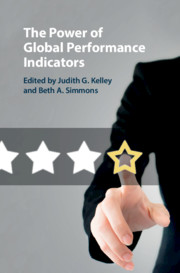Book contents
- The Power of Global Performance Indicators
- The Power of Global Performance Indicators
- Copyright page
- Contents
- Figures
- Tables
- Contributors
- Preface
- 1 Introduction
- Part I Ratings, Rankings, and Regulatory Behavior
- Part II The Normative Influence of Ratings and Rankings
- Part III Beyond and Within State
- Part IV Skeptical Voices
- 11 Third-Party Policymakers and the Limits of the Influence of Indicators
- 12 The Millennium Development Goals and Education
- 13 Global Performance Indicators: Themes, Findings, and an Agenda for Future Research
- Index
- Chapter 3: Appendices
- Chapter 4: Appendices
- Chapter 5: Appendix
- Chapter 6: Appendix
- Chapter 7: Appendix
- Chapter 8: Appendix
- Chapter 10: Appendix
- Chapter 11: Appendix
- Chapter 12: Appendix
- References
11 - Third-Party Policymakers and the Limits of the Influence of Indicators
from Part IV - Skeptical Voices
Published online by Cambridge University Press: 28 February 2020
- The Power of Global Performance Indicators
- The Power of Global Performance Indicators
- Copyright page
- Contents
- Figures
- Tables
- Contributors
- Preface
- 1 Introduction
- Part I Ratings, Rankings, and Regulatory Behavior
- Part II The Normative Influence of Ratings and Rankings
- Part III Beyond and Within State
- Part IV Skeptical Voices
- 11 Third-Party Policymakers and the Limits of the Influence of Indicators
- 12 The Millennium Development Goals and Education
- 13 Global Performance Indicators: Themes, Findings, and an Agenda for Future Research
- Index
- Chapter 3: Appendices
- Chapter 4: Appendices
- Chapter 5: Appendix
- Chapter 6: Appendix
- Chapter 7: Appendix
- Chapter 8: Appendix
- Chapter 10: Appendix
- Chapter 11: Appendix
- Chapter 12: Appendix
- References
Summary
Do Global Performance Indicators (GPIs) influence the application of material power? While existing research has shown that GPIs can provoke reform through social mechanisms, material power is an important tool for influencing states resistant to social pressure. We investigate whether GPIs shape third-party policymakers’ decisions to employ material power in the fight against corruption, an important component of the good governance agenda. We theorize that GPIs influence policymakers by acting as focal points that provide information and establish standards of behavior. We test this argument for a highly visible GPI: Transparency International’s Corruption Perceptions Index. We find that while this GPI garners significant media attention, it does not influence policymakers’ decisions to punish corruption offenders by withdrawing or altering foreign aid. Our results raise important scope conditions on the power of GPIs and suggest that their ability to alter state behavior through third-party material mechanisms may be limited.
Keywords
- Type
- Chapter
- Information
- The Power of Global Performance Indicators , pp. 341 - 374Publisher: Cambridge University PressPrint publication year: 2020
References
- 2
- Cited by

